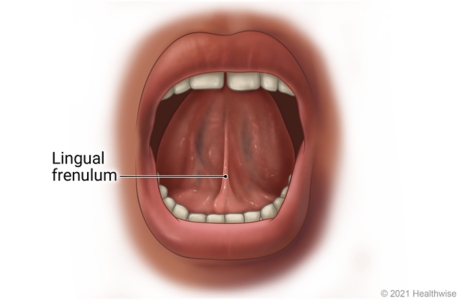The nurse is performing an assessment of the client's mouth. The nurse recognizes that the tissue that connects the tongue to the floor of the mouth is the:
Frenulum
Palate
Uvula
Papillae.
The Correct Answer is A
A. Frenulum:
The frenulum is a thin band of tissue in the mouth that connects the tongue to the floor of the mouth. It aids in the tongue's movement and flexibility during speaking and swallowing.
B. Palate:
The palate refers to the roof of the mouth. It has two parts: the hard palate (at the front, made of bone) and the soft palate (at the back, made of muscle). The palate plays a crucial role in speech and swallowing.
C. Uvula:
The uvula is a small, fleshy extension at the back of the soft palate in the mouth. It participates in various functions, including speech articulation, preventing food from entering the nasal cavity during swallowing, and producing certain sounds.

D. Papillae:
Papillae are small, raised structures on the tongue that contain taste buds. They are responsible for detecting different tastes: sweet, salty, sour, bitter, and umami (savory). Papillae give the tongue its rough texture.
Nursing Test Bank
Naxlex Comprehensive Predictor Exams
Related Questions
Correct Answer is A
Explanation
A. The pupils constrict when the examiner's index finger slowly moves toward the client's nose.
This statement is correct. Visual accommodation is the process by which the eye's lens changes shape to focus on objects at varying distances. When an object moves closer to the eyes, the pupils constrict to adjust and focus on the near object, preventing double vision.
B. The client involuntarily blinks in the presence of bright light directed over the pupils during the eye exam.
This statement describes the pupillary light reflex, not visual accommodation. The pupillary light reflex is the response of the pupils to light exposure.
C. The client's peripheral vision becomes sharper when the examiner shines a light over the pupils.
This statement is not accurate. Peripheral vision sharpness is not related to visual accommodation. Visual accommodation mainly involves adjusting focus for objects at varying distances.
D. The pupils dilate when the examiner's index finger slowly moves toward the client's nose.
This statement is incorrect. Pupils should constrict, not dilate, when focusing on a near object (as in visual accommodation). Dilation occurs in low-light conditions or in response to sympathetic stimulation.

Correct Answer is A
Explanation
A. Auricle (Pinna):
The auricle, also known as the pinna, is the visible external part of the ear. It consists of movable cartilage and skin. When administering eardrops, pulling the auricle up and back helps to straighten the ear canal, allowing the drops to enter the ear effectively.
B. Mastoid Process:
The mastoid process is a bony prominence located behind the ear. It is not a part of the outer ear structure involved in administering eardrops.
C. Outer Meatus:
The outer meatus, also known as the external acoustic meatus or ear canal, is the tube-like structure leading from the auricle to the eardrum. It is the passage through which eardrops are administered. Pulling the auricle up and back helps to straighten the outer meatus for the proper administration of eardrops.
D. Concha:
The concha refers to the bowl-shaped depression next to the ear canal. While it is a part of the outer ear, pulling the concha is not a technique used for administering eardrops. The auricle, specifically, is manipulated to facilitate the process.

Whether you are a student looking to ace your exams or a practicing nurse seeking to enhance your expertise , our nursing education contents will empower you with the confidence and competence to make a difference in the lives of patients and become a respected leader in the healthcare field.
Visit Naxlex, invest in your future and unlock endless possibilities with our unparalleled nursing education contents today
Report Wrong Answer on the Current Question
Do you disagree with the answer? If yes, what is your expected answer? Explain.
Kindly be descriptive with the issue you are facing.
